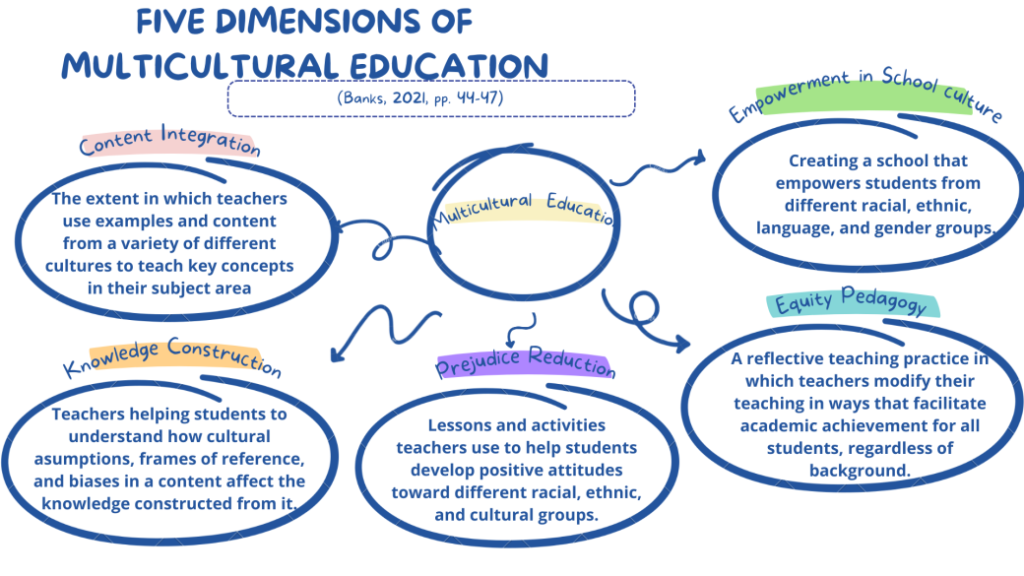DIMENSIONS OF MULTICULTURAL EDUCATION
Multicultural education refers to an approach to teaching and learning that recognizes and incorporates the diverse cultural backgrounds and perspectives of students. The goal of multicultural education is to foster an inclusive and equitable learning environment where students from various ethnic, racial, religious, linguistic, and social backgrounds feel respected, valued, and represented.
DIMENSIONS OF MULTICULTURAL EDUCATION

James A. Bank discussed five Dimensions of Multicultural Education is used widely by school districts to conceptualize and develop courses, programs, and projects in multicultural education.

CONTENT INTEGRATION
According to Banks (1991) Content integration deals with the extent to which teachers use examples and content from a variety of cultures and groups to illustrate key concepts, principles, generalizations, and theories in their subject area or discipline. For example, teacher may give example from many religions (e.g Muslim religion, he give example of film-My name is khan, but I am not a terrorist, He may give example of Bajrangi Bhai Jaan film) races, urban, rural, slum areas etc. For example, while teaching fundamental rights or human rights and duties, teacher may quote Bhagvat Geeta, Kuran Sharif, Shri Guru Granth Sahib Ji and The Bible.

THE KNOWLEDGE CONSTRUCTION PROCESS
According to Banks (1991), the knowledge construction process describes teaching activities that help students to understand, investigate, and determine how the cultural assumptions, frames of references, perspectives, and biases of researchers and textbook writers influence the ways in which knowledge is constructed. In this dimension first of all content from different cultures in fused in the social curriculum. Then the teacher can make new units of content, can reassemble them in correlated way etc. It also includes changing the ways in which teachers and students view and interact with knowledge, helping them to become knowledge producers, not merely the consumers of knowledge produced by others.

PREJUDICE REDUCTION
Prejudice means preconceived unfair (favourable or unfavourable) feeling or opinion which is not based on reason or actual experience. It leads to discrimination. Prejudice reduction describes lessons and activities used by teachers to help students to develop positive attitudes toward different racial, ethnic, and cultural groups. These conditions include positive images of the cultural groups in the materials and the use of multiethnic materials in a consistent and sequential way towards different cultures. It also helps students to understand how cultural identity is influenced by the context (situation) of schooling and the attitudes and beliefs of dominant social groups.

AN EQUITY PEDAGOGY
According to Banks, an equity pedagogy exists when teachers modify their teaching in ways that will facilitate the academic achievement of students from diverse racial, cultural, socio-economic, and language groups. This includes using a variety of teaching styles and approaches that are consistent with the range of learning styles within various cultural and ethnic groups. For example, individualized teaching, inductive approach, project related to group background, language-based teaching, interdisciplinary approach, constructive approach, personalized system of information etc.

- Rejects the cultural deprivation paradigm
Family and social environment (members) discourage them to gain knowledge skills, and attitudes required for academic success. This paradigm believe that cultural practice of these learners are weak, inadequate and inferior. That is why this paradigm focus to change learners’ behaviour so that they can fit in mainstream school culture. Whereas Equity Pedagogy assumes that more the cultural diversity, the more learners have strengths, skills and knowledge.

- Role of Culturally responsible teachers:
According to Gay, teachers practice culturally responsive teaching when an equity pedagogy is implemented. They use instructional materials and practices that incorporate important aspects of the family and community culture of their students.

- Focus cooperation than competition:
Aronson and Gonzalez (1988) reported that the academic achievement of African American and Mexican American students is increased when cooperative teaching activities and strategies, rather than competitive ones, are used in teaching. Cooperative learning activities also help all learners, to develop more positive racial attitudes. The students from different cultural groups must feel that they have equal status in intergroup interactions.

AN EMPOWERING SCHOOL CULTURE
School Culture includes beliefs, perceptions, relationships, attitudes and written as well as unwritten rules that shape or influence school functioning. It also includes functioning. It also includes physical and emotional safety of learners, discipline and celebration of different cultures in the school. This dimension involves restructuring the culture and organization of the school so that students from diverse regional racial, ethnic, socioeconomic, and language groups experience equality.
The implementation of this dimension requires that the total environment of the school be reformed, including the attitudes, beliefs, and action of teachers and administrators, the curriculum and course of study, assessment and testing procedures, and the styles and strategies used by teachers. Members of the school staff examine and change the culture and social structure of the school.

To implement multicultural education effectively, teachers and administrators must attend to each of the five dimensions of multicultural education described above. They should use content from diverse groups when teaching concepts and skills, help students to understand how knowledge in the various disciplines is constructed, help students to develop positive intergroup attitudes and behaviours, and modify their teaching strategies so that students from different racial, cultural, and social-class groups will experience equal educational opportunities. The total environment and culture of the school must also be transformed so that students from diverse ethnic and cultural groups will experience equal status in the culture and life of the school.
| Also study | Also study |
| Dimensions of multicultural education | Benefits of multiculturalism education |